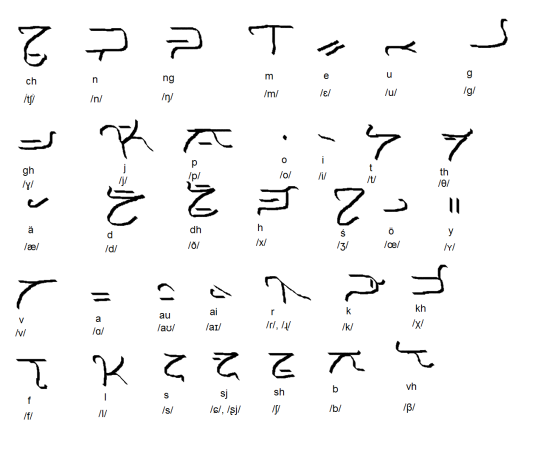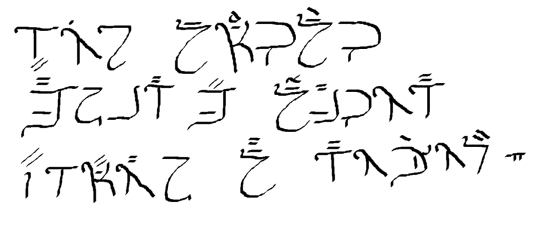If ELV had a Wiki...
▲
0▲ 0 ▼ 0
This public article was written by [Deactivated User], and last updated on 21 Mar 2015, 15:42.
[comments] elvphonologymiscgrammarwip
4. Irregular pronouns
?
?
?FYI...
This article is a work in progress! Check back later in case any changes have occurred.
This article is a work in progress! Check back later in case any changes have occurred.
High Elevjeti (Elevjetas Nadras [ɛlɛv'jɛʈɑʂ 'nɑɖɾɑʂ]) is an Oktedhen language that originated on the mini-continent of Kólhg, amongst the Kolgri people. Approximately 7 million people speak it as a native language, and another million as a second language, making it the Oktedhen language with the second-largest number of speakers (the first being Eskjan). Most of these speakers live in Sjanne, a small country comprising the southern tip of the Northeastern Continent and a few islands off its coast, where it is the official language and the most common.
The language evolved from Kolgri, which was spoken by the peoples of the island before recorded history. When the Octed religion came to the island, most followed the orthodox version, worshipping all eight gods equally, but after the loss of the Light of Ystr, those in the north specifically held to the belief that they were the children of Ystr, the Goddess of Light. In time, differences developed between the language spoken by the orthodox followers and that spoken by those who worshipped Ystr, separating into the Old High Oktedhen and Elevjeti languages, the latter from which High Elevjeti descended.
Elevjeti, the predecessor to High Elevjeti, thrived in Kólhg, with the Elevjeti people prospering economically. According to their beliefs, the Goddess was the source of their prosperity as a reward for their faithfulness, and it was around this time that a meteor struck the earth. The woman who found the blue, crystal-like object claimed to have been visited by the Goddess in human form, who told her that the Elevjeti were immortal, and that keeping the jewel safe would allow them to keep this immortality. A special room was constructed in the capital city of the First Northern Kingdom to hold it, and their prosperity continued, along with the long life they had been promised. In the first year of the era known as the Age of Death, a winter came with so much snow that it forced the Elevjeti people further inland, and upon the spring melt they found that the crystal was gone.
In the first five centuries of the Age of Loss, First Northern Kingdom still prospered economically despite the declining population. The rich nobles prospered the most, and they were so separated from the plebeians that eventually wealthy and poor dialects of the Elevjeti language developed, which then became entirely separate languages after the migration, but were quite close to different languages at the time of it. The hierarchy of the Elevjeti society became stricter and so did the divide between the wealthiest nobles and the poorest commoners.
Year 628 of the Age of Loss brought a winter that was snowier and colder than any recorded one, and when the time passed for the warm season to come, it remained winter. After six years, the cold had no end in sight, and nearly a third of the FNK population had perished, and so most of the remaining Elevjeti decided to migrate southeast, settling in what is now Sjanne.
Now amongst Northeastern languages, Elevjeti borrowed a considerable number of words and grammar rules. Since the majority of emigrants were noble, the High Elevjeti dialect prevailed and Low Elevjeti was almost exclusively confined to those who had stayed on the island. The borrowings and Northeastern influences were one cause of the rapid separation of LE and HE. Today the two are mutually unintelligible with only a few similar words in common.
Morphological typology
High Elevjeti is a mostly fusional language, with the affixed morphemes that conjugate and decline words often having multiple meanings. For example, in the word ingmyl ("we will die") the suffix -myl not only implies future tense, but also first person plural inclusive and indicative mood. The exception to this is HE nouns, which are declined in a blend of fusional and agglutinative styles. With nouns, the nominative singular is the default, with no added suffixes. To change the case or number, a suffix is added, and to change both, two suffixes are added.
Siresh, n. dandelion
| nom | acc | |
| sing | siresh | sireshai |
| pl | sireshel | sireshelai |
Both -el and -ai are suffixes exclusive to the first declension of nouns, but in order to change the word from nominative singular to accusative plural, both must be tacked onto the end of the word. This agglutinating feature of the language is believed to be
Nouns
Nouns come in five genders/classes: masculine, feminine, neutral animate, neutral inanimate, and plant (or natural), but these have nothing to do with their declination. Instead, the nouns are categorized into two simple declensions: words that end in a vowel and words that end in a consonant. The gender/class of the noun is used to determine the conjugation of the adjective it is paired with, if any. There is little rule to how the nouns are classed, although in many cases the noun is categorized by its meaning; for example, idos ("queen") is feminine, because a queen is female. Also, sometimes the last vowel in a word may determine its class: a is usually masculine, y and ö usually feminine, and the rest have no specification.
High Elevjeti is a nominative-accusative language, and nouns are declined according to nine cases: nominative (default), accusative, dative, genitive, comitative, ablative, allative (also used as locative), vocative, and instrumental. They also can decline by five numbers: singular (default), plural, paucal, collective, and negative.
Pronouns
High Elevjeti is a highly pro-drop language, with pronouns in the nominative case rarely being used at all, except for emphasis, in poetry, or when clarification for gender is needed. Beyond that, pronouns are declined in four more cases: accusative, dative, genitive, and comitative. The genitive case, unlike with nouns, is marked by a prefix on the possessed object rather than a suffix on the possessor; this is the only occurrence of a prefix in High Elevjeti.
Verbs
High Elevjeti has two sets of verbs: those that originated in Oktedhen languages, and those that were borrowed from other languages. There are several moods in which they can be conjugated, the most common being indicative and subjunctive, which are marked on the verb itself. Other moods can be added with particles that are put before the verb itself or at the beginning of the verb phrase, a feature that emerged during a time of heavy trade and contact with the Tlarak.
Verbs are conjugated to agree with their subject, and verbs in Class 1 (Oktedhen origin) average nearly 150 possible forms, whereas verbs in Class 2 (foreign origin) have about 50. Conjugations are made according to person, tense, and mood, and though Class 1 has more possible forms than Class 2, the simple past, present, future, and perfect are present in both classes. A variety of moods are used in both classes, although the subjunctive is generally not used in Class 2.
Pronunciations differ between dialects of High Elevjeti, but the pronunciation considered "standard" is based on the Sjannen dialect. Standard High Elevjeti has 27 consonants and 10 vowels--8 standard, each with a long counterpart, and 2 that are allophones that have begun to disappear. High Elevjeti is characterized mostly by stops and fricatives, particularly the alveolar and velar, and a palatal approximant [j] often immediately following or blended with one.
Syllabic consonants may occur in any place where a consonant is preceded by another consonant and not followed by a vowel, or more rarely, when a consonant is bounded on front and back by other consonants. The most common syllabic is r, realized as [ɹ̩], but it can happen with any consonant except for [q]. However, not every consonant in these circumstances is syllabic, and blends occur more frequently.
| Labial | Dental | Alveolar | Palatal | Velar | Uvular | |
| Nasal | m | n | ŋ | |||
| Stop | p b | ʈ ɖ t͡s | t͡ʃ | k g | [q] | |
| Continuant | f v β | θ ð | ʂ ʃ ʒ ɻ [ɬ] | ɕ j | x ɣ | χ |
| Lateral | l | |||||
| Flap | [ɾ] |
1 [p] and [b] cannot occur word-finally
2 [ɬ] occurs only adjacent to other unvoiced consonants, and loanwords from Tlarak
3 [q] occurs only in loanwords
4 [ɕ] occurs only paired with [j] as a blend
| Front | Near front | Central | Back | |
| Close | i [i:] | u [u:] | ||
| Near close | [ɪ] ʏ [ʏ:] | |||
| Close mid | o [o:] | |||
| Mid | [ə] | |||
| Open mid | ɛ [ɛ:] œ [œ:] | |||
| Near open | æ [æ:] | |||
| Open | ɑ [ɑ:] |
1 [ɪ] and [ə] occur only as allophones of [i] or [ʏ] and [ɑ] or [ɛ] in unstressed syllables, respectively
There are two distinct vowel diphthongs, [aʊ] and [aɪ], although the latter may be realized as [aj] in the southwest of Sjanne, particularly near the capital. Although fast speakers may cause successive vowel sounds to blend together, the standard is to pronounce them as two separate phonemes.
Stress
Stress in High Elevjeti is often randomly distributed. Usually, the penultimate syllable receives stress, and this is always the case in a word whose final syllable is a syllabic consonant. Antepenultimate stress also occurs, a bit less frequently than penultimate. Initial stress is somewhat rare except in words of two syllables, and final stress never occurs in a word with more than two syllables.
High Elevjeti is written in the Kolgri script, an abjad in which consonant phonemes are represented by individual letters, and vowels are represented with diacritic markings placed either above or below the symbol of the consonant that they follow.

In this example of standard Sjannen writing, the only diacritic written below its consonant is in the first word, méroś, and this is because é [ɛ:] is a long vowel. The syllabic consonants [g̩] and [ɹ̩] in hasgma and dughanrma, respectively, are written the same as other consonants, and it is the speaker's logic of pronunciation that causes them to be realized as syllabic.
All human beings are born free and equal in dignity and rights.
Méroś djaindin hasgma he dughanrma emjeras da markirte.

Note that although the "rt" in the final word would be changed from [ɻʈ] to [t͡ʃ] in speaking, it is written as "rt" by most speakers, although some may change it to "ch", but this is not standard and inappropriate for things like legal documents and royal decrees. Also, in the first word of the third line, emjeras, the beginning character is a "vowel carrier", used for words that begin with a vowel. ✎ Edit Article ✖ Delete Article
Comments






